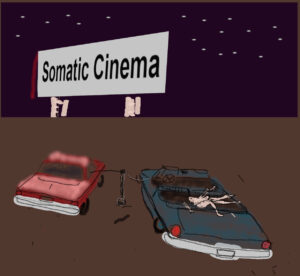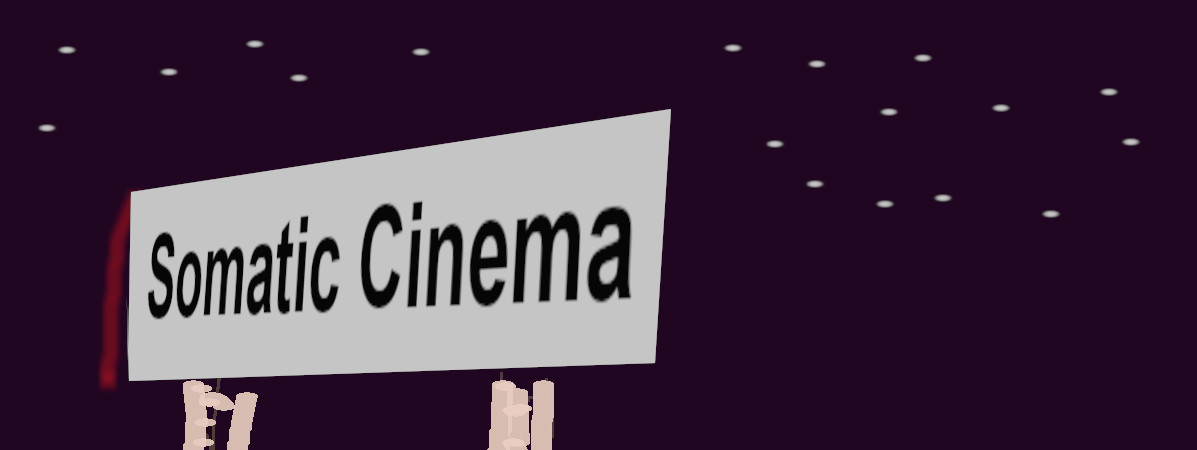Book Review – Somatic Cinema By Luke Hockley
In this first ever Refreshing Resource I will examine multiple concepts of the book Somatic Cinema and how each might relate to technology image addiction.

The first concept is that
individual relationship with film can be meaningful.
When the topic of porn addiction is discussed, there is often a standpoint of how to stop this behavior and why. I can’t tell you how many resources I came across in my early days of realizing consuming porn had become an issue that explained the science of how bad it was for my brain. While informative and slightly motivational, none of these resources acknowledge there is a relationship between myself and the pornographic images. This scientific perspective which focuses on the downfalls of addiction allows little room for the casual consumer curious about their relationship with sex. To be fair, I was NOT this curious person at the time. I was an escape addict with a self-abusive relationship with pornographic videos. In contradiction Hockley wrote: “Being in the cinema does not offer an escape from the real world. Rather it provides a means by which to descend into one’s own inner world. The cinema provides a gateway…to bypass the defenses of consciousness and to gain valuable insight into the core of our psychological being.” Built into this concept is that no two cinematic experiences are exactly the same. This goes for different people and for watching the same video at different times. During adolescence I knew little about inner love and my outer love life was even less developed. Now sitting in midlife while engaged in a healthy outer relationship, the meaning of what I watch is different.
The concept I intend to question here is whether or not a relationship to pornographic videos or social media videos can reveal unconscious material and thus act as a meaning making activity? In other words, are our attempts to completely stop screen behaviors leading to missing out on symbolic imagery?
My hope is to approach this topic without minimizing the struggle of an addict stuck in an unhealthy relationship with their consumption of internet videos nor diminish any abuse of performers. Truthfully, I have witnessed very little discussion within publications dedicated to porn addiction on how the specific content of the pornographic images have potential to bring inner psychological images of viewers to the surface. Can we recognize when “naughty” images actually hold individual meaning for the viewer? Certainly not if they are never really talked about, shamed, and kept secret for your entire life.
The second concept from Somatic Cinema
Psychologically effective films that have a collective appeal seem to find a means through which to express something that is fundamental the psyche...In and of itself psychological intention is not enough to create meaning for the film viewer.
The book discusses movies with an original intention to be psychological that are stale in evoking actual psychological impact, at least for the writer. Then there are other movies that seem to hit a psychological nerve. Without intending to a creator has somehow revealed something in you that you never had the ability to express. This is sometimes referred to as missing the plot because it often has nothing to do with the real intention of the movie. You can be sitting there watching some b-rate movie, and a 10 second scene rocks your world. Somehow it is depicting exactly what you need to experience at this very moment in psychological time. You can’t even explain to your friend what happened in the movie, all you can think of is that one scene. That one noise. That one flash of an animal. The actors, writers, and directors had no intention other than making a movie, and yet here you are one scene closer to wholeness in your life.
A viewpoint psychologists, addicts, and filmmakers alike can take is to accept images regardless of where they came from. Sometimes with books, movies, or music, we can become a little arrogant with our association of where psychological material originates. We tend to take certain experts or philosophies as the only way into the unconscious. Believe it or not a comedian in a strip club might be able to reveal more of your ‘unconscious’ material than the great dali lama. Can we recognize when “naughty” images are just as important as the best motivational Ted talk of the year?
Although there is a lot more packed into this 150 page book, the last concept I want to bring attention to is that:
the BODY experiences anxieties, stress, and worries of which we are only partly aware.
The idea Hockley reminds us of here is there are both biological AND psychological mechanisms that regulate our body. You can’t ever fully separate the mind from the body. Your Bodymind-Mindbody is always together even if you seem hypnotized by mind altering screen flashes, the body is still there. This might appear obvious when you feel physical arousal in your pants, but it is often ignored in writings about pornography addiction. We have a tendency to assume that screens are only affecting our brains.
It seems to me one problem with porn addiction is a constant ignoring of the body expressing it’s need to touch, feel, embrace and fuck some other body. The biological needs of reproduction are just one form of body regulation. Being loved, caressed, massaged, pleased, or releasing sexual tension are all forms of body regulation too, psychological body regulation. If we only experience those needs in our mind, aka through fantasy images, the psychological body is not complete. So, if you are struggling with pornography addiction my humble advice is to pay attention to your body. What are the psychological needs the body is expressing? Does it need to move more often? Can you change position wile reading this article and have a different result?
All psychological activity requires energy, whether it is anxiety, melancholy, happiness, FOMO, or an escape into screen time. Our accepted views on how to describe this energy (named libido) is typically divided in different disciplines of psychology. In the version of psychology rooted in the ideas of Freud, this libido is purely sexual in nature. Libido is sex drive to some people. In the version of psychology in line with Jung (which is where this book sits) the libido may contain a sexual component but is better understood as psychological life-energy as a whole. Libido is life-energy. If we assume this psychological life energy has a fixed amount for a given person, aka energy cannot be created nor destroyed, then we can examine how it shifts during a single activity like watching a movie.
For example, let’s imagine the body is melancholic from something earlier in the day and is sitting slumped over on the couch watching a G rated movie. For now, just keep sex out of the picture. There is some amount of this libidinal energy residing in the person that momentarily is redirected from melancholy into the fantasy image of the movie. The content of the movie image may determine the direction of the psychological energy that was originally felt. If anger provoking images are in the movie, the body now has to shift psychological energy away from the melancholy into another area, anger. Now this angry energy no longer matches the person’s body language which is slumped over the couch. So, the body and the mind are splitting resources, one utilizing psychological energy for anger while the other uses it for melancholy. This splitting of resources seems exhausting, and just writing it here makes me want to go to sleep. Now imagine the content on the screen matches the original melancholy, it is a sad movie. The psychological energy is dedicated to both processing the sadness of the day and fantasy sadness of the movie. We are doubling down on the melancholy energy and might even feel an infinite sadness, like we don’t even have the energy to smash pumpkins (sorry this is a lame reference). Now, offering a third type of content in the movie, an image appears that magically is exactly at the right time and place to balance our psychological energy. The affect of the melancholy becomes less intense and the psychological energy can be redirected. Energy can now be used more productively toward balanced mental and physical health. We become more content and able to cope with life.
Alright this might be easier said than done. Difficulties arise in that we can’t just web search for “magical content” and get the images we need at every given time. I used the term magic purposefully to imply a force larger than ourselves. Don’t use this as an excuse to keep searching for that perfect video, you will never find it that way. You are also not powerless in your relationship with porn or social media. One hope is that you will be able to recognize its potential energy when you experience it. Maybe you will even mention it to your counselor during a talk therapy session. The counselor might even inquire more about the content that you are addicted to. Or maybe instead of just thinking of yourself as addicted to porn, you can see each time you view the material as a somatic cinematic experience.
The book Somatic Cinema has been a refreshing resource in my personal attempt to understand porn addiction. My hope is that the concepts might reach your body where ever you are. As for tech related screen addictions, if you can start to recognize when a film is or is not personally meaningful to you, accept the image without judgement of where it came from, and listen to the bodies attempts to process psychologically I believe your habits will start to change.
Good Luck.
Clark Williamson
Note: The concepts in Somatic Cinema intertwine with the purpose of this blog, which is why I find this particular book fitting to be our first Refreshing Resource. The cover of the book claims to examine the “Relationship between body and screen” This description is very in line with the mission of the Imago Refresh blog, which is to provide resources to restore people’s inner livelihood and empower change in their habits around technology screen usage. As with all of my reviews, I recommend going straight to the source if you have questions about the material. PLEASE Keep in mind this is my experience and translation of someone else’s work.



Comments are closed